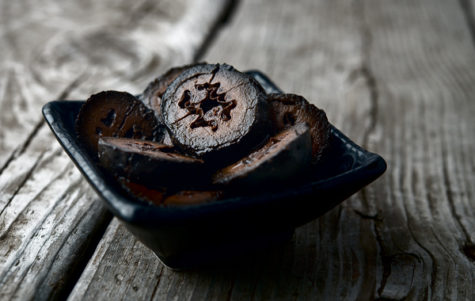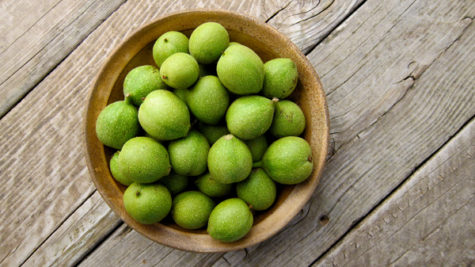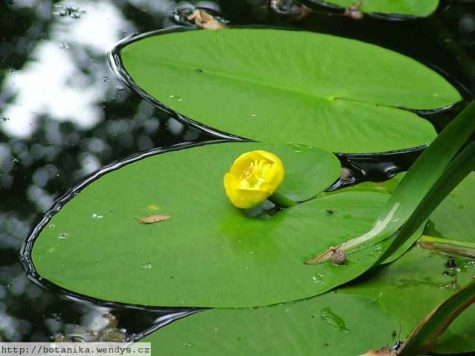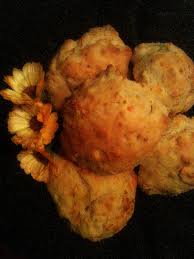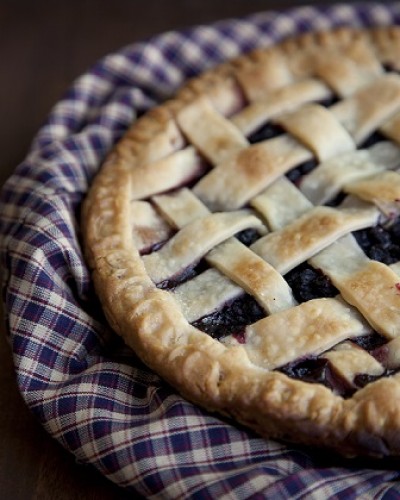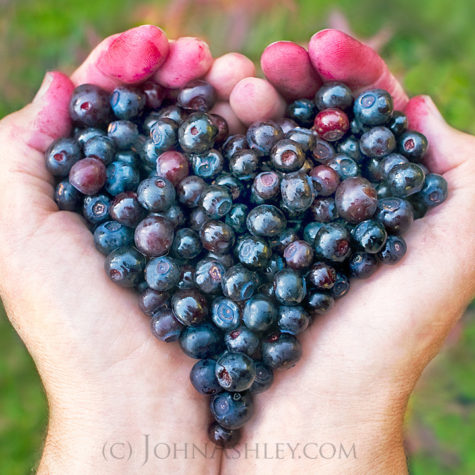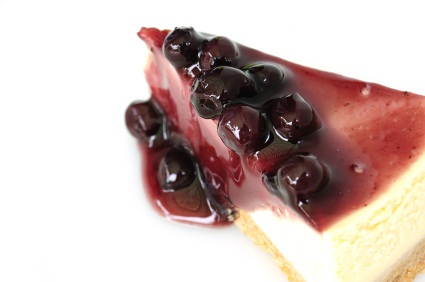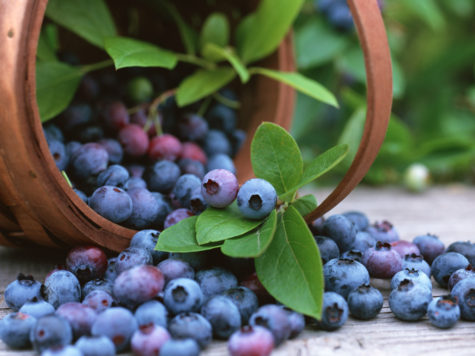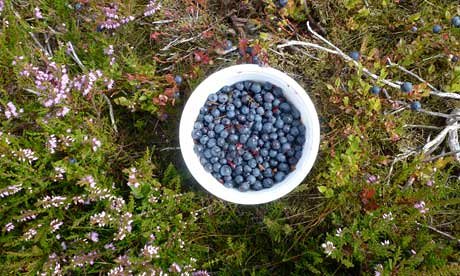Monthly Archives: January 2017
Pickled Walnuts
What do you do with them? They are particularly good with cheddar, and in Britain they are traditionally part of a ploughman’s lunch, with other pickles, cheese and cold meats. They can also be tossed into beef or lamb stews (pot pies and pasties, too!) in wintertime, and in summertime served in cool salads alongside tomatoes, and accompanying shellfish such as scallops or shrimp.
The flavor is a bit like eating solid steak sauce, with a little floral aroma and a zephyr of bitterness that just barely let you notice it. Eaten alone they are fairly soft, puckery and strangely floral with a Worcestershire-Heinz 57 taste to it.
For the recipe you need green, unripe walnuts to make pickles. And yes, you use the whole thing, hull and all.
It is very important that you test to see that the walnuts are green enough to use. How to do this is slice an unripe nut in half. You need to do this, either with a knife or a stout needle or a long nail, because you have to catch the unripe walnuts before the shell forms. Once that shell forms inside the walnut’s hull, you’re too late.
The traditional harvest date in England is late June.
Any walnuts will work with this recipe, from tiny native Arizona walnuts to big, fat English walnuts, which are the kind you buy in stores. But you do need them hull and all, so this only works if you have a tree nearby.
The process for pickling walnuts is not hard at all, but it takes more than a week. You need to brine the green walnuts for a good long time before they will be ready to pickle properly. The brine time helps with preservation and removes some of the bitterness in the unripe walnuts. Once brine pickled, they are pretty durable. Do you need to sun-blacken the walnuts? No, but doing so gives you a nice, uniform look to them. Otherwise they will be olive green in some places, blotchy black in others.
The pickling liquid in my recipe is very traditional; you’ll see variations on it throughout England. I’ve also made a Chinese-inspired version with Sichuan peppercorns and star anise replacing the allspice.
Makes about: 3 to 4 quarts.
Prep Time: 8 days, fermenting time
Cook Time: n/a
- About 50 to 60 green, unripe walnuts
- 1/2 cup kosher salt
- 1/2 gallon water
- 2 quarts cider or malt vinegar
- 1 tablespoon cracked black pepper
- 1 tablespoon cracked allspice berries
- 10 cloves
- 1 ounce ginger, smashed (about 1 1/2-inch pieces)
- 1 cup brown sugar
Instructions:
- Dissolve the salt in the water to make a brine. Put on some rubber gloves if you have them, because walnut juice will stain your hands for weeks — and it won’t come off. Trust me on this one. Properly gloved, stab each walnut with a fork in several places; this helps the brine penetrate. Submerge the walnuts in the brine and let them ferment for 8 days at room temperature.
- Remove the walnuts and put them on a baking sheet and leave them outside in the sun for a day, until they turn uniformly black. You can do this step without gloves if you want.
- Pack the walnuts into quart jars. Bring the remaining ingredients to a boil and pour over the walnuts. Leave very little headspace in the jars. Seal and keep in a cool place, either the fridge or a basement — you just want them to rest below 70°F — for at least a month before you eat them. Kept this way they will last a year.
Note: When you use the walnuts in recipes or for lunches, be sure to keep the vinegar as it is said to be a great gargle for coughs when you have a cold or the flu.
From: Honest Food
Pond Lily Popcorn
You can eat the seeds of yellow pond lily (Nuphar lutea) also called spatterdock, yellow water-lily, or cow lily. Here’s a recipe from Janice Schofield, an Alaskan herbalist:
Pop 1/4 cup of seeds in 2 tablespoons of oil and flavor with butter, nutritional yeast and whatever else you fancy. The Assiniboin and Micmac peoples ate them: fried in bear fat.
Enjoy!
Calendula Biscuits
- 2 cups all-purpose flour
- 4 teaspoons baking powder
- ½ teaspoons salt
- ¼ cup butter
- 2 tablespoons calendula petals, finely chopped
- ¾ cup milk
- 2 tablespoons butter
Preheat oven to 450 F. Mix dry ingredients together in a bowl. Cut in butter and Calendula petals with a pastry knife until the mixture is mealy in texture. Quickly stir in the milk. Turn out onto a floured board. Shape and kneed (as little as possible) into an oblong shape about 1-½ Inches thick.
Place on a heavy cookie sheet (or use one cookie sheet atop another). With a sharp knife, cut dough into 2-inch squares. Dot each biscuit with butter. Bake for 10 to 12 minutes or until lightly browned. Serves 6 to 8.
From: Grandmas Wisdom
Hawthorn Flower Tea
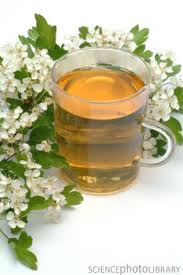 Hawthorn flower tea infusion. This is a medicinal drink which is good for blood pressure, any heart disorders, including blocked arteries.
Hawthorn flower tea infusion. This is a medicinal drink which is good for blood pressure, any heart disorders, including blocked arteries.
Here’s how to make it:
- Pick as many hawthorn flowers as you can, along with the leaves around them.
- Drink them fresh or dry them in the sun and store.
- Put some into a large cup of boiling water and leave to stew for 20 minutes.
- Strain and add 1 teaspoon honey to the liquid.
Found at River Cottage
Bilberry Pie
With An ORAC score of 111, bilberries rank among some of the most antioxidant rich foods in the world. This means that per cup consumed they pack a much healthier punch than most all other foods and have excellent anti-aging, anti-cancer and pro immune system properties to help both fight off and prevent a plethora of health issues and diseases.
Here’s a recipe for a yummy desert that is not only good, it’s good for you!
Ingredients:
In a large bowl add together:
- 5 cups Bilberries
- 6 Teaspoons Cornstarch
- 1 to 1.5 cups- sugar
- 1 teaspoons grated lemon rind (optional)
- 3- dabs of butter
Directions:
Mix the above ingredients together with a spoon so that everything is well distributed; pour into the bottom pie shell as it sets in the pie plate. Dot the top of the mixture with 2 or 3 dabs of butter. Top off with the second pie shell. Once it is correctly positioned you should have a 1 inch overlap on the top crust so that it can be crimped with the bottom crust. Crimp or pinch the two crusts together and make a decorative edge to seal the two pie crusts.
The pie can be refrigerated until you are ready to bake or baked immediately. To bake, preheat your oven to 450 degrees. Place the pie on the middle shelf of your oven and bake for 15 minutes then turn the temperature down to 350 degrees and continue baking for 30-40 minutes or until the filling starts to bubble over. Once the pie looks done and the crust is a light golden brown, it should be done.
Take it out and let the pie cool on a cooling rack until it is ready to serve. Some notes: baking your pie may take less time or a little longer depending on your oven. Just in case it starts to bubble over the side, place a sheet under the pie plate to save cleaning the oven.
From: NW Wild Foods
Bilberry Shrub
Shrubs are like syrups made with a healthy dose of vinegar. Most often flavored with fruit, shrubs are the grown-up answer to syrups. Shrub can be used in many of the same places as syrup, such as in fizzy water and cocktails, or to dress fruit salads, but the vinegar used to make shrub gives it a perfect punch of sour meets sweet.
There are some shrubs that I prefer to make with fruit that has never been cooked, only macerated with sugar. However, I think it is easier to maximize the flavor and amount of juice in bilberries by making a cooked syrup.
Preparation time: 2 hours
Ingredients:
- 1 part fruit (all parts by volume, not weight)
- 3 parts sugar
- 1 part water
- Rice vinegar or other light clear vinegar, equal in measure to the amount of bilberry syrup
Directions:
1. In a pot, lightly crush the bilberries together with the sugar, and let them sit for an hour.
2. Add the water, and bring the bilberries to a boil. Being such small berries, this is all they need to cook. Remove the pan from the heat, and let the bilberries cool to room temperature.
3. Strain out the solids from the bilberry syrup, and be certain to save them to put atop ice cream or your morning toast.
4. Measure the syrup, and combine it with an equal amount of rice vinegar. Stir gently to combine. Pour the shrub into mason jars, and store them in a very cold pantry or refrigerator for at least six months before serving. Once aged, the sharp edges of the vinegar will soften and become the perfect balance for the fruit.
Found at: Zester Daily
Wild Bilberry Sauce
Bilberry, or Vaccinium myrtillus, is a true treasure of the Great Pacific Northwest. With An ORAC score of 111, these berries rank among some of the most antioxidant rich foods in the world. This means that per cup consumed they pack a much healthier punch than most all other foods and have excellent anti-aging, anti-cancer and pro immune system properties to help both fight off and prevent a plethora of health issues and diseases.
Bilberry Sauce
This simple Bilberry Sauce makes a delicious topping for ice cream or cakes. Enjoy!
Ingredients:
- 2 cups bilberries (frozen or thawed)
- 1/2 cup sugar
- 2/3 cup water
- 1 tablespoons cornstarch
- 1/2 teaspoon lemon juice
Directions:
In a medium saucepan combine ingredients and stir until smooth. Bring to a boil, stirring constantly and cook for 5 minutes at a gentle simmer. Serve hot or cold.
Directions:
In a medium saucepan combine ingredients and stir until smooth. Bring to a boil, stirring constantly and cook for 5 minutes at a gentle simmer. Serve hot or cold.
Adapted from a recipe on NW Wild Foods
Huckleberry Cream Scones
Huckleberries (V.Myrtilllus or Bilberry) is used traditionally as a natural remedy for kidney stones, scurvy and urinary infections. Bilberries can be used as a supportive treatment for diabetes, both because the berries reduce blood sugar and because they can prevent eye diseases and blood vessel disorders that can accompany diabetes.
Here’s a recipe for Huckleberry Cream Scones:
Preparation time: 30 minutes
Yield: 6 servings
Ingredients:
- 2 cups flour
- 1 tablespoon baking powder
- ½ teaspoon salt
- 4 tablespoons cold butter, cubed
- ¾ cup plus 1 tablespoon cream
- 1 egg, beaten
- ½ teaspoon vanilla
- 1 cup huckleberries, frozen
- 1 tablespoon coarse sugar
Directions:
1. Preheat the oven to 400 F. In a medium bowl, combine the flour, baking powder and salt.
2. Add in the cubes of butter, and gently toss them with a fork to coat them with flour. Then use the back of the fork to crush the pieces of butter into smaller and smaller pieces as they combine with the flour. Stop when most of the butter is unrecognizable.
3. Make a hole in the center of the flour and butter mixture. Add the ¾ cup cream, egg and vanilla to the depression and use the fork to gently beat them together before gently combining them with the flour and butter. Just before the dough comes together, add the huckleberries. As gently as possible, continue stirring, just until the dough holds together.
4. Line a baking sheet with parchment paper and press the dough into a circle 1½ inches thick. Use a butter knife to cut the circle into six wedges. Gently separate the wedges so that they are at least 2 inches apart, and blunt the pointy end with your finger.
5. Brush the top of each with the extra tablespoon of cream, and sprinkle on some of the coarse sugar.
6. Bake for 20 minutes, or until the bottoms and tops of the scones are lightly brown.
From: Zester Daily
Bilberry Smoothie
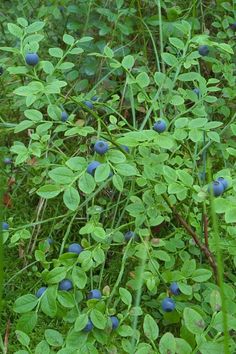 Bilberries have been used for nearly 1,000 years in traditional European medicine. Bilberry fruits have been used in the traditional Austrian medicine internally (directly or as tea or liqueur) for treatment of disorders of the gastrointestinal tract and diabetes. Herbal supplements of V. myrtillus (bilberry) on the market are used for circulatory problems, as vision aids, and to treat diarrhea and other conditions.
Bilberries have been used for nearly 1,000 years in traditional European medicine. Bilberry fruits have been used in the traditional Austrian medicine internally (directly or as tea or liqueur) for treatment of disorders of the gastrointestinal tract and diabetes. Herbal supplements of V. myrtillus (bilberry) on the market are used for circulatory problems, as vision aids, and to treat diarrhea and other conditions.
Here’s a recipe for a simple bilberry smoothie:
- 1 cup of bilberries
- 1 cup milk
- ½ cup of yogurt.
Whizz in a blender. Add honey and/or lemon juice to taste.
Cold Bilberry Soup
Some people use bilberry for conditions of the heart and blood vessels including hardening of the arteries (atherosclerosis), varicose veins, decreased blood flow in the veins, and chest pain. Bilberry is also used for chronic fatigue syndrome (CFS), hemorrhoids, diabetes, osteoarthritis, gout, skin infections, gastrointestinal (GI) disorders, kidney disease, and urinary tract infections (UTIs).
Here’s a wonderful dessert/dish for a summer’s day:
Take a quart of bilberries, bruise or mash. Add the same amount of water and a little lemon juice. Simmer, add sugar to taste. If you don’t like the seeds and skins, you can strain the liquid through a fine sieve or cheesecloth. Dissolve a little cornstarch and add to thicken, but take care not to use too much. Simmer a little while longer, then allow to cool and put in the fridge. Whip some cream. When the bilberry soup is cold enough, serve with dabs of fresh whipped cream.
